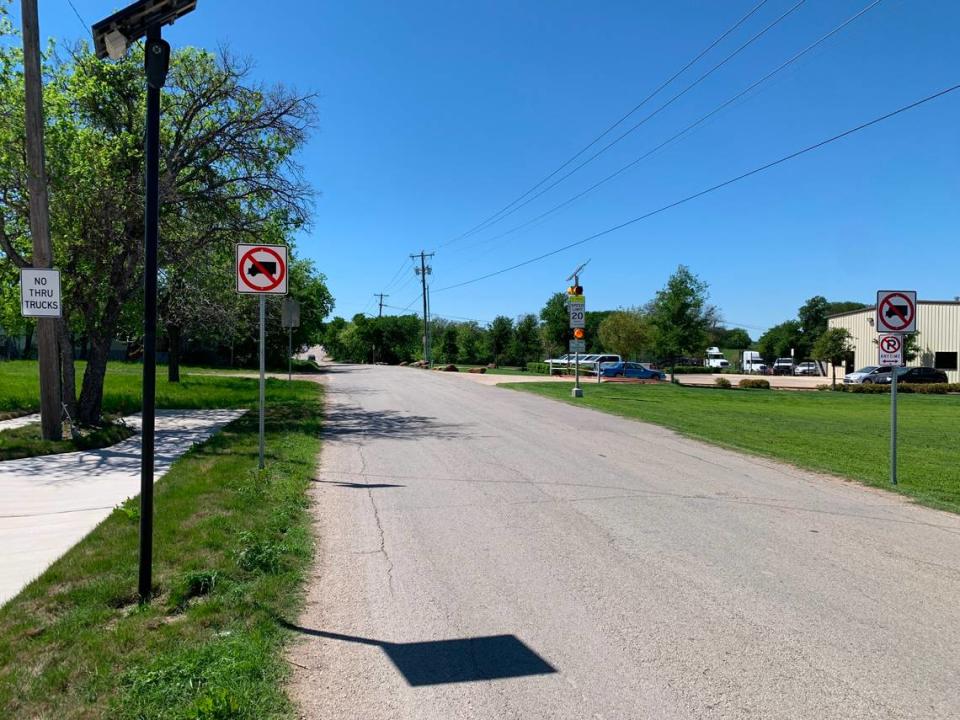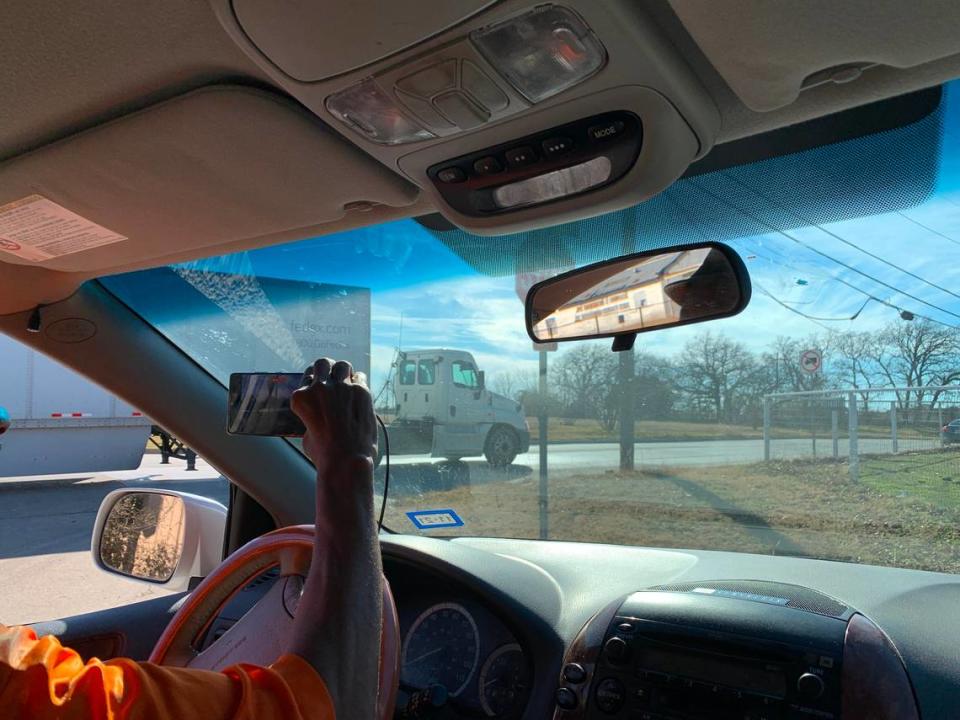Trucks keep driving through no-truck roads. What can Fort Worth do about it?
“Look how small these babies are.”
Teena James motioned to the liberated school children streaming out of W.M. Green Elementary on a cloudless Thursday afternoon in early February.
“I want you to see how tall an 18-wheeler is.”
As if summoned, one then reared into view. The white freight truck wheezed up David Strickland Road toward the intersection with Parker Henderson, a small caravan of cars trailing patiently behind.
“That truck ain’t supposed to be here!” James’ friend and fellow activist Letitia Wilbourn exclaimed.
The truck passed, revealing a police car parked on a dirt shoulder farther up the street, from where the semi-trailer had come. “And there go the police!” Wilbourn said, more indignant this time. “The police are sitting right there.”
Too often, James and Wilbourn say, large commercial trucks from nearby industrial zones drive through their neighborhood in southeast Fort Worth on roads too narrow for their size, too fragile for their weight and too close to homes for their emissions.
They and other residents report spotting semi-trailers lumbering down no-truck roads with daily frequency and near total impunity.
Police say they crack down on bad trucking as best they can, given the force’s limited manpower what officers describe as other, more pressing priorities. They point to signage improvements and efforts to communicate with chronic offenders as signs of their commitment to enforcement.
What emerges is a pattern repeated across much of Fort Worth: residents contending with the adverse effects of booming industry, while the city — and its infrastructure — strain to manage the challenge.
School Zone
Fort Worth established W.M. Green Elementary School in 1959.
An unofficial history of the school describes the surrounding area around the time of its founding as “rural,” its campus “surrounded by oak trees.”
“Woods, just woods,” C.E. Brown remembered of the landscape, sweeping the horizon with her hand as she rested against the front of her pickup parked a few dozen yards from the school’s entrance.
Brown, 54, with red-tinted hair and an easy, full smile, taught at W.M. Green in the late 1980s. She and her three daughters, all W.M. Green alumni, grew up in Echo Heights, the once quiet residential community around the school situated roughly seven miles southeast of downtown.
Vestiges of the neighborhood’s rustic terrain remain visible around the campus. The school’s only access road, David Strickland, is tight, uneven, and scantily lit. Cattle still roam the pasture across the street. Lacking a paved sidewalk, children living in the mobile home community next door squeeze through a dirt path to get to and from class.
Decades of rapid industrialization has eaten away much of the greenery. City officials designated the neighborhood an “industrial growth center” in 2000, touting its proximity to major freeways. Groves have since given way to garages, ranches to warehouses.
W.M. Green now shares David Strickland with vast truck lots owned by some of the nation’s largest logistics firms, including XPO, UPS, and Estes Express. A nearby repair shop would be a shorter field trip than the neighborhood park. In recent years, Echo Heights residents fended off multiple proposals to construct an industrial facility on the farmland right across the street.
The city pitched two square no-truck signs along the road about 400 feet from the campus’ eastern edge in an attempt to shield the school from truck traffic.
“They have no business to go through David Strickland continuing through the school,” said Rajnish Gupta, the chief traffic engineer for the city’s Transportation and Public Works department. “On that stretch, they don’t need to go there.”
Freight drivers, residents say, routinely ignore the signage.
Four parents parked curbside for pick-up one April afternoon each described seeing two-to-four trucks heave by as they offload their children for class and wait to retrieve them later in the day.
“It’s just something that happens,” one father said.
A school employee corralling kids into back seats reported seeing five to seven on any given day. What companies they belonged to is uncertain.
Whether offending drivers are misguided by their GPS systems or consciously shaving time off their trips is also not entirely clear.
“With all the construction going on over at Loop 820 and I-20, I know they’re opening and shutting different routes around there,” said Nathan Holsey, an officer in the Fort Worth Police Department’s commercial vehicle enforcement division.
In response to inquiries for this story, UPS said it never routes its freight trucks through residential neighborhoods.
“We have designated feeder paths for all our destinations that purposefully avoid non-truck areas,” a company representative wrote in response to questions from the Star-Telegram. “If we are in a non-truck area, it is either because of a detour or a slight chance that our driver got lost.”
XPO, FedEx, Estes, and Abrams Expedited, a smaller trucking group, did not respond to requests for comment.
“There are many circumstances where trucks are using it as a shortcut,” Gupta said. “That’s the issue in Echo Heights.”

Enforcement
Tensions between haulers and homeowners have flared across the Fort Worth area, from small towns on its outskirts to fledgling subdivisions within city limits.
The strain is a byproduct of converging growing pains.
The Metroplex’s population has soared over the past decade. W.M. Green had one class per grade in the early 1960s ; it now educates more than 500 pupils, according to its website.
The region’s freight industry has boomed in tandem. Dallas-Fort Worth led the nation in active logistics real estate construction last year. The amount of land set aside for cargo storage has almost doubled in size since the turn of the century.
Orchestrating the steady coexistence of residences and industry has become a pressing puzzle for city planners. Appropriate signage, Gupta says, is one step toward solving it.
“In those situations where we see there are alternate routes available and they shouldn’t be using that road, we put a no-truck sign,” he said. Traffic and truck route assessments led the agency to cordon off the western halves of Martin Street and David Strickland and parts of Parker Henderson.
Enforcing the sign’s decrees is another challenge entirely.

Police “can’t be there 24/7,” Gupta continued. “The sign is a static sign.”
The FWPD generated nine reports for traffic incidents along David Strickland Road between Jan. 1, 2023, and March 4, 2024, according to records requested by the Star-Telegram. Only two dealt with commercial trucks; none resulted in warnings or citations. (The Star-Telegram had originally asked for truck violation records for the entire city; the department said it couldn’t provide them since it doesn’t categorize infractions by vehicle type.)
One November afternoon the department received a call from a resident about an 18-wheeler parked illegally near the intersection of David Strickland and Parker Henderson. The incident report’s activity log states an officer arrived at the scene roughly six hours later; no further steps appear to have been taken.
The same resident phoned again in early December to complain about another truck parking infraction near the intersection. An officer pulled up to the site 12 hours after the call; by then, the log states, the truck had gone.
“We do get a lot of calls in that area of David Strickland about trucks,” Reginald Traylor, Holsey’s sergeant, told the Star-Telegram. “We will continue to go there as time permits.”
The unit’s four officers are tasked with carrying out the vast array of state and federal ordinances governing truck traffic — from lane violations, to load inspections, to faulty lights. Any Fort Worth police officer can ticket a truck for driving along no-truck streets; but agency-wide staffing gaps have, Traylor said, contributed to “sporadic” enforcement.
“All departments are short in manpower,” he said. “With the city as large as it is, and as short as we are, it’s personnel.”
Holsey recalls pulling over truckers in Echo Heights for road violations before. (Reports for those interactions may not appear in the department’s regular traffic offense records because its team logs incidents in a separate database, he says. Neither Holsey nor his sergeant could estimate how many warnings or citations they’d issued to truck sign violators since last January.)
“I’ve only gone up there a couple times,” in the past year, Holsey said. “We have a lot of other stuff going on — some higher priorities when it comes to commercial vehicle inspections.”
Holsey insists that the department is committed to policing truck infractions despite its limitations. Until late last year, he says, there had only been one no-truck sign separating the two halves of David Strickland. The police and the city’s transportation department installed another and moved them farther up the road, in response to resident concerns and trucker quibbles about the old signage being too difficult to see.
“Since the signs have been placed in a more visible area, we’re going to make an effort to go door-to-door to speak with different companies and their safety directors and let them know our concerns,” Holsey said. “Enforcement will be done in the coming weeks.”
What that enforcement might look like he couldn’t say. But residents hope it will be swift and decisive.
“As individuals, you get so frustrated fighting for the little stuff you do have,” Brown sighed.